
AI workflow management systems simplify operations by unifying tools, automating processes, and reducing costs. Businesses are cutting software expenses by up to 98%, improving efficiency, and maintaining security. Here’s a breakdown of the top platforms:
| Platform | Key Features | Starting Price | Target Users | AI Model Support |
|---|---|---|---|---|
| Prompts.ai | 35+ AI models, enterprise-grade | $99/month | Enterprises | GPT-5, Claude, Gemini |
| Vellum AI | Multi-step workflows, collaborative | Free | Teams, Enterprises | LLMs |
| Zapier | No-code, basic automation | $29.99/month | SMBs | Limited AI features |
| Make | Drag-and-drop, branching logic | $9/month | SMBs, Teams | OpenAI, Google |
| n8n | Open-source, self-hosted | Free/$20/month | Developers, SMBs | Custom integrations |
| Pipedream | Developer-focused, serverless | $45/month | Developers, Teams | 2,800+ APIs, LLMs |
| StackAI | Compliance-heavy workflows | Free/Custom | Regulated sectors | Customizable |
| SnapLogic | Enterprise integrations | Custom | Large Enterprises | Vendor-agnostic |
| Relevance AI | Task-specific agents | $19/month | SMBs, Teams | LLMs, AI tools |
| VectorShift | Multi-LLM, developer tools | $25/month | Developers | GPT-4, Anthropic |
| Gumloop | Node-based, browser automations | $97/month | Technical Teams | LLMs, AI tools |
| Relay.app | AI-first, human-in-the-loop | Custom | All sizes | Anthropic, OpenAI, etc. |
Choose a platform based on your team’s technical skills, workflow complexity, and budget. Whether you’re managing simple automations or scaling enterprise AI operations, these tools offer solutions to fit your needs.
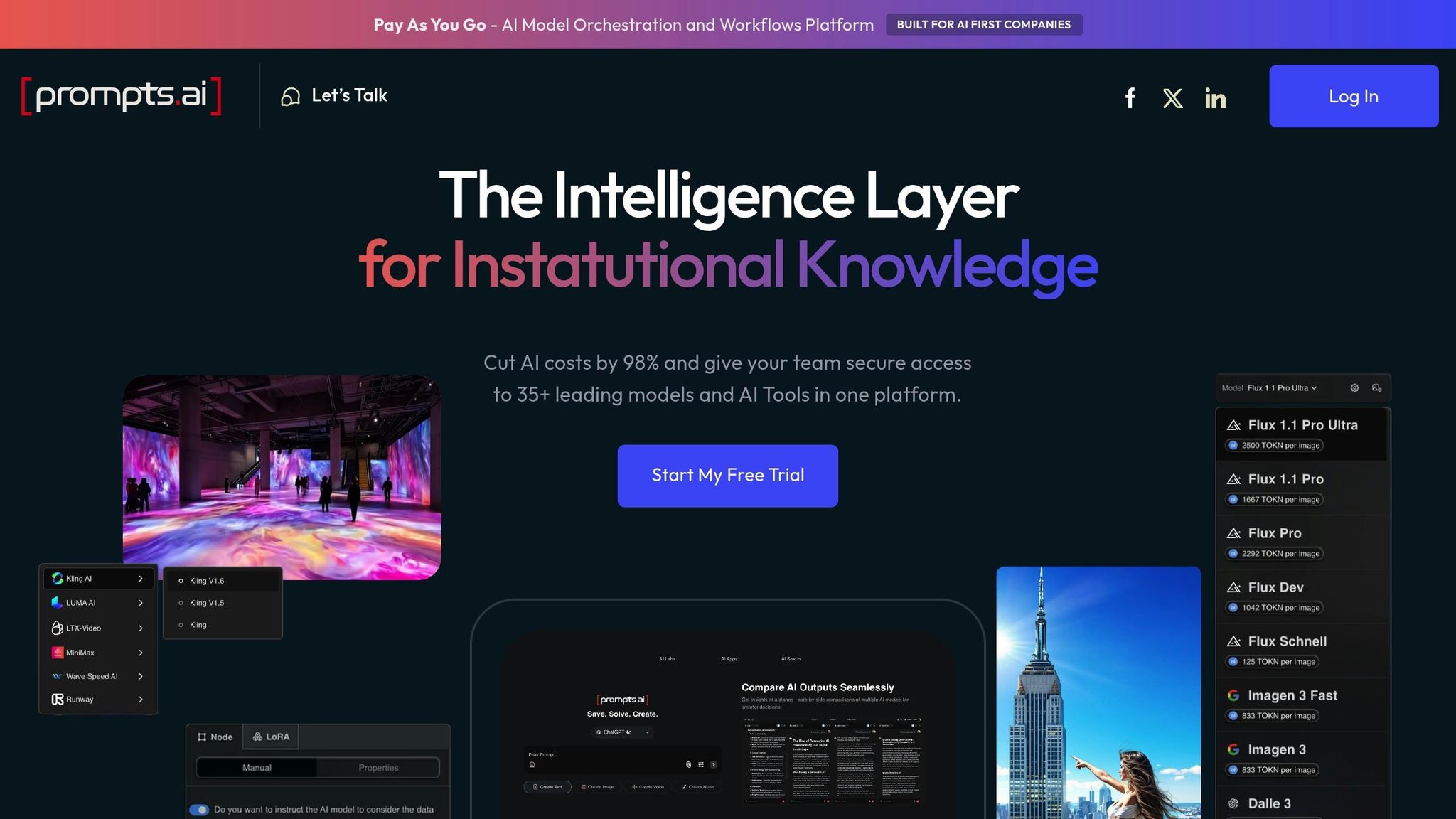
Prompts.ai is a powerful platform designed to unify AI workflows, offering enterprise users access to more than 35 leading AI models through a single, secure interface. By consolidating tools like GPT-5, Claude, LLaMA, and Gemini, it simplifies the often chaotic landscape of AI tools into one cohesive system.
What truly sets Prompts.ai apart is its focus on enterprise-ready orchestration, not just offering access to individual models. As of October 2025, it boasts over 10,000 active users, including teams from Fortune 500 companies spanning industries like finance, healthcare, and e-commerce. This unified platform creates a seamless foundation for advanced interoperability across diverse AI models.
Prompts.ai excels at integrating multiple AI models, allowing users to combine or switch between them effortlessly within a single workflow. This capability is especially valuable for complex tasks requiring different models, such as using one for data analysis and another for content creation.
The platform’s standout feature is its ability to chain multiple prompts and models together, enabling advanced, multi-step automation that goes beyond basic tasks. Users can compare leading AI models side by side, streamlining the process of selecting the best tool for specific needs and significantly improving team efficiency.
In May 2025, Johannes V. demonstrated the platform’s potential by orchestrating several AI tools to create immersive animations.
Prompts.ai simplifies workflow automation by unifying various AI models and tools. Its robust integration capabilities include pre-built connectors, RESTful APIs, and webhooks, making it easy to embed AI automation into systems like Slack and Salesforce.
Developers benefit from detailed API documentation and SDKs for Python and JavaScript, allowing for custom integrations and automation extensions. For non-technical users, the visual workflow builder ensures accessibility. For instance, an e-commerce company can use the platform to automate product description creation by linking its product database with a large language model. This automation drafts descriptions, routes them for human review, and publishes approved content, speeding up time-to-market. Such streamlined integration not only simplifies operations but also ensures predictable costs.
Prompts.ai tackles one of the biggest hurdles in AI adoption: unpredictable costs. By consolidating access to over 35 AI models on one platform, it slashes AI expenses by up to 98%, eliminating the need for multiple subscriptions.
The pricing structure is straightforward and tailored for U.S. businesses, with plans based on usage and team size. The Core plan starts at $99 per user per month, offering 250,000 TOKN Credits, unlimited workspaces, and unlimited collaborators. The Pro plan is available for $119 per user per month with 500,000 TOKN Credits, while the Elite plan costs $129 per user per month and includes 1,000,000 TOKN Credits. Studies show that teams using Prompts.ai reduce prompt development time by 30–50%, translating into significant cost savings and faster project completion.
Prompts.ai is designed to support large-scale operations with robust governance features tailored for enterprises. Security and compliance are top priorities, with the platform adhering to SOC 2 Type II, HIPAA, and GDPR standards to protect data. The SOC 2 Type II audit was initiated on June 19, 2025, and users can monitor real-time security updates via the Trust Center.
"[prompts.ai] connects enterprise users to the top AI language models like GPT, Claude, LLaMA, and Gemini via one interface. Eliminate tool sprawl, streamline workflows, and enforce governance at scale."
- Prompts.ai
The platform’s enterprise features include unlimited workspaces, pooled TOKN Credits, centralized storage, compliance monitoring, and governance tools, ensuring smooth deployments across departments. With the ability to add models, users, and teams instantly, organizations can scale operations efficiently without losing control, ultimately boosting productivity.
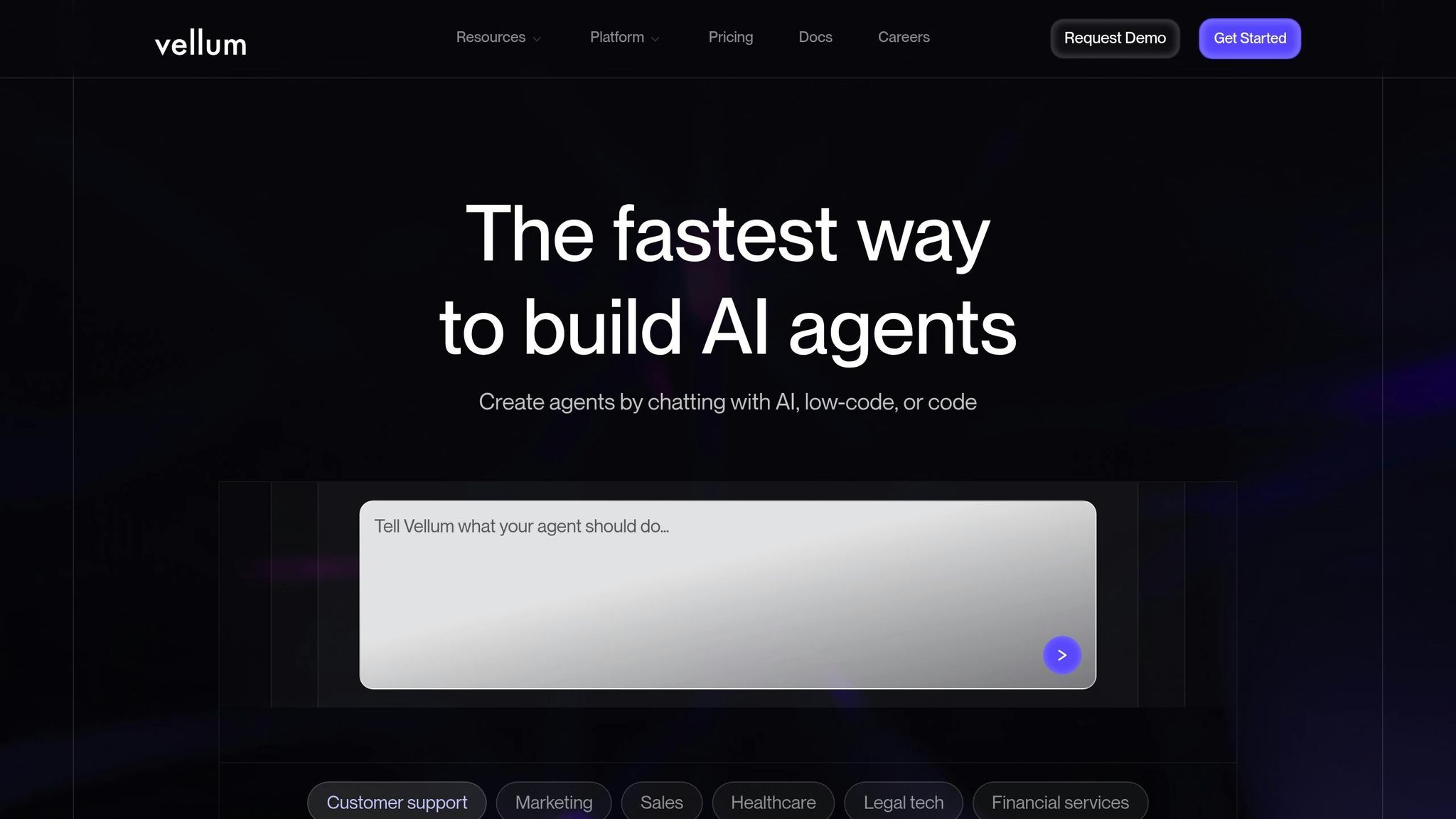
Vellum AI stands out as a platform designed to address the growing need for efficient, enterprise-level AI workflow management. Like Prompts.ai, it provides a streamlined solution for integrating large language models (LLMs) with business systems, all while ensuring robust enterprise-grade security.
By combining prompt engineering, workflow orchestration, and collaboration tools into a single workspace, Vellum AI enables teams to design, test, and launch multi-step AI agents with ease. Its collaborative approach bridges the gap between technical and non-technical team members, allowing everyone to contribute to refining prompts, configuring workflows, and automating complex processes.
Vellum AI’s architecture is designed to simplify the creation of complex agents. Features like retrieval, semantic routing, and agent orchestration allow teams to harness a variety of AI capabilities without the usual technical challenges that come with integrating disparate systems.
The platform provides visual builders alongside SDKs for TypeScript and Python, making it accessible to non-technical users while giving developers the flexibility to add custom nodes. This dual approach ensures that both engineers and non-technical contributors can collaborate effectively. The smooth integration of these tools not only simplifies workflows but also sets the stage for cost efficiency and scalable operations.
Vellum AI offers a free tier to get started, with enterprise pricing available through consultation. By consolidating workflow management into one platform, it helps reduce operational overhead and improve cost efficiency.
Vellum AI is built for production-level reliability, featuring built-in evaluations, versioning, regression testing, and detailed observability tools. From node-level traces to comprehensive workflow dashboards, these capabilities ensure workflows remain dependable and manageable as they scale. The shared visual environment enhances team collaboration and oversight, while developers can leverage the SDK to implement additional hardening measures.
"Vellum is the AI-first workflow platform that lets non-technical teammates and engineers co-build reliable, testable, observable AI workflows that scale." – Vellum AI
This focus on reliability and governance provides organizations with the tools needed to confidently deploy AI workflows. With comprehensive monitoring, testing, and collaboration features, Vellum AI ensures high performance and dependability, even as operations grow in complexity.

Zapier stands out as a top-tier workflow automation platform, thriving in a no-code environment. Although it wasn't initially designed with AI at its core, the platform has incorporated AI features to handle repetitive tasks and simplify operations across various software tools.
Zapier's reliability and broad integration capabilities are its strongest assets. With a G2 rating of 4.5 out of 5 stars from over 1,397 reviews and a Capterra rating of 4.7 out of 5 stars from more than 3,023 reviews, users frequently highlight its ability to connect with a vast array of tools. This makes it a go-to choice for organizations of all sizes, from nimble startups to large-scale enterprises.
Zapier takes a practical approach to integrating AI. While it’s not an AI-native platform, its AI features are designed to meet straightforward automation needs. These include tasks like text processing, data extraction, and basic decision-making, catering to businesses that require simple yet effective solutions.
One of Zapier's key strengths is its user-friendly, no-code interface, which empowers non-technical users to build automated workflows. Through its visual builder, teams can create "Zaps" - automated actions triggered by specific conditions across apps. Thanks to its long-standing reputation for reliability and an extensive library of integrations, most businesses can implement automation without needing custom development.
Zapier’s tiered pricing model is straightforward and scales with business needs, offering flexibility for different budgets:
| Plan | Price | Tasks/Month | Key Features |
|---|---|---|---|
| Free | $0 | 100 | Unlimited Zaps, two-step Zaps |
| Pro | $29.99 | Higher limits | Multi-step Zaps, premium apps, webhooks |
| Team | $103.50 | Advanced limits | 25 users, shared Zaps, SAML SSO |
| Enterprise | Custom | Unlimited | Unlimited users, advanced admin permissions |
The free tier is appealing for basic use, but costs can increase as workflows grow in complexity. Beyond pricing, Zapier enhances its offerings with governance features tailored for enterprise-level needs.
Zapier supports scaling businesses with enterprise-grade features like SAML SSO, shared workspaces, and advanced administrative controls. The Team and Enterprise plans foster collaboration by allowing multiple users to work on automation projects while maintaining oversight. However, some users have noted that the dashboard can become sluggish when managing a large number of workflows - a drawback that may affect performance as automation scales.
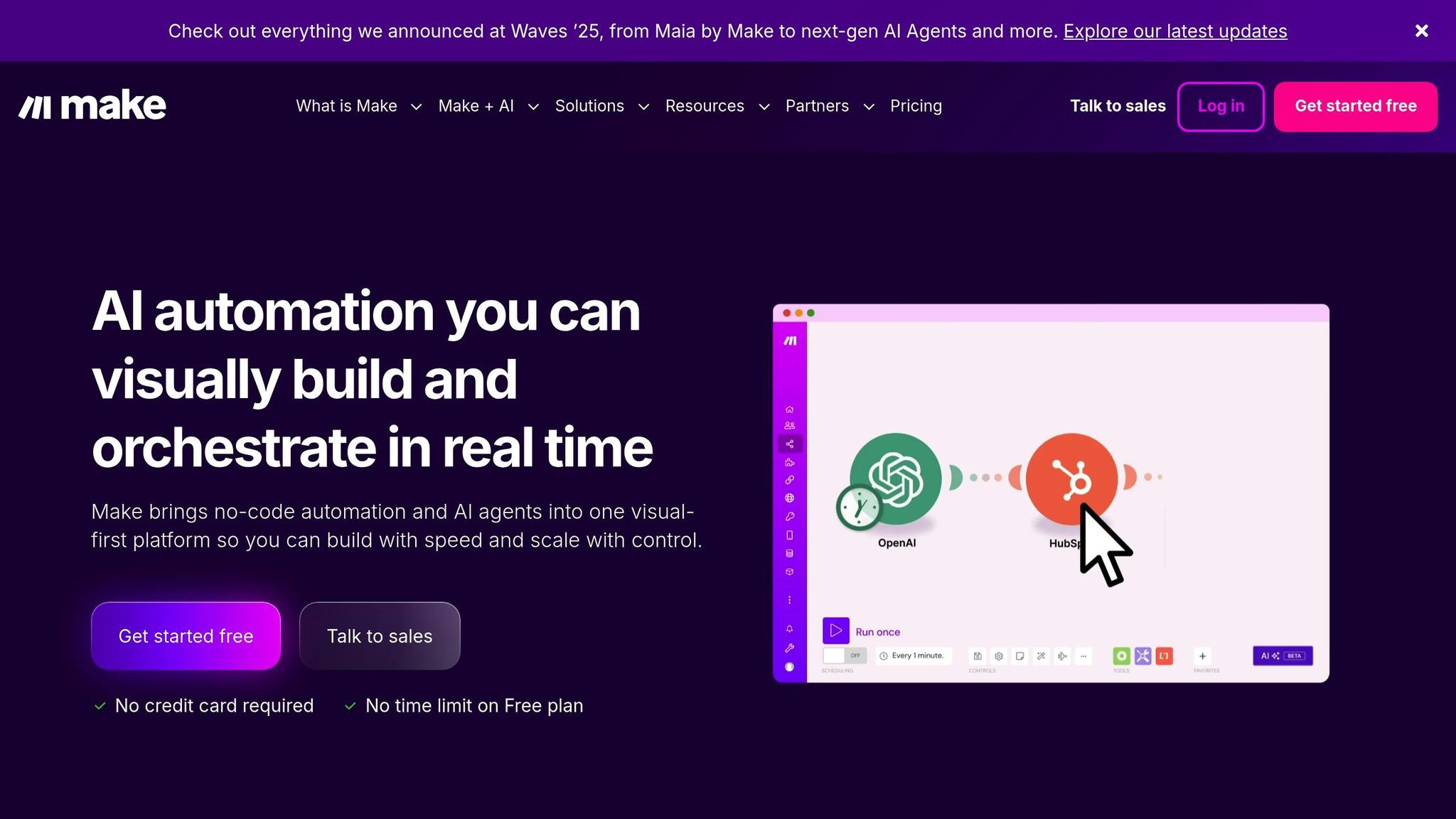
Make is well-known for its intuitive drag-and-drop interface, designed to help teams create multi-step workflows, or "scenarios", that seamlessly integrate AI-powered tasks into broader automation strategies. This visual approach empowers teams to handle complex, branching processes with ease, incorporating custom variables and real-time data to meet the demands of intricate business operations.
What truly sets Make apart is its ability to handle sophisticated workflows. Unlike platforms that focus on straightforward trigger-action setups, Make supports multiple decision points, data transformations, and conditional logic. This allows businesses to design workflows that align closely with their real-world processes.
Make integrates seamlessly with AI services like OpenAI and Google, enabling teams to embed AI functionalities directly into their workflows. For example, scenarios can pull data from various sources, process it through AI models for tasks like analysis or content creation, and then distribute the results across multiple systems - all within a single, visually designed workflow. This capability ensures that AI-driven tasks can easily become a natural part of existing business processes.
The platform’s drag-and-drop builder makes creating even complex workflows straightforward. It supports advanced features like branching, iterators, and data transformations, eliminating the need for custom coding. Teams can also take advantage of routing, error handling, mapping, and replay tools to manage high-volume operations effectively. These features allow organizations to adapt workflows in real time as business conditions change, offering a tailored solution to meet specific needs.
Make stands out with its cost-effective pricing model. It offers a free tier and paid plans starting at approximately $9 per month. Unlike user-based pricing, Make uses an operations-based model, allowing businesses to scale their automation efforts without incurring extra costs for additional users. This approach makes it an appealing choice for teams looking to grow while keeping expenses under control.
Make’s architecture is built to scale, featuring robust error handling and replay capabilities to ensure workflows remain reliable, even during complex data transformations or when integrating multiple systems. The visual scenario builder encourages collaboration between technical and non-technical team members, making it easier to design workflows that adapt to evolving business needs. With its ability to handle real-time data streams and custom variables, Make provides the flexibility required to unify intricate automation processes into manageable workflows that grow alongside your organization.
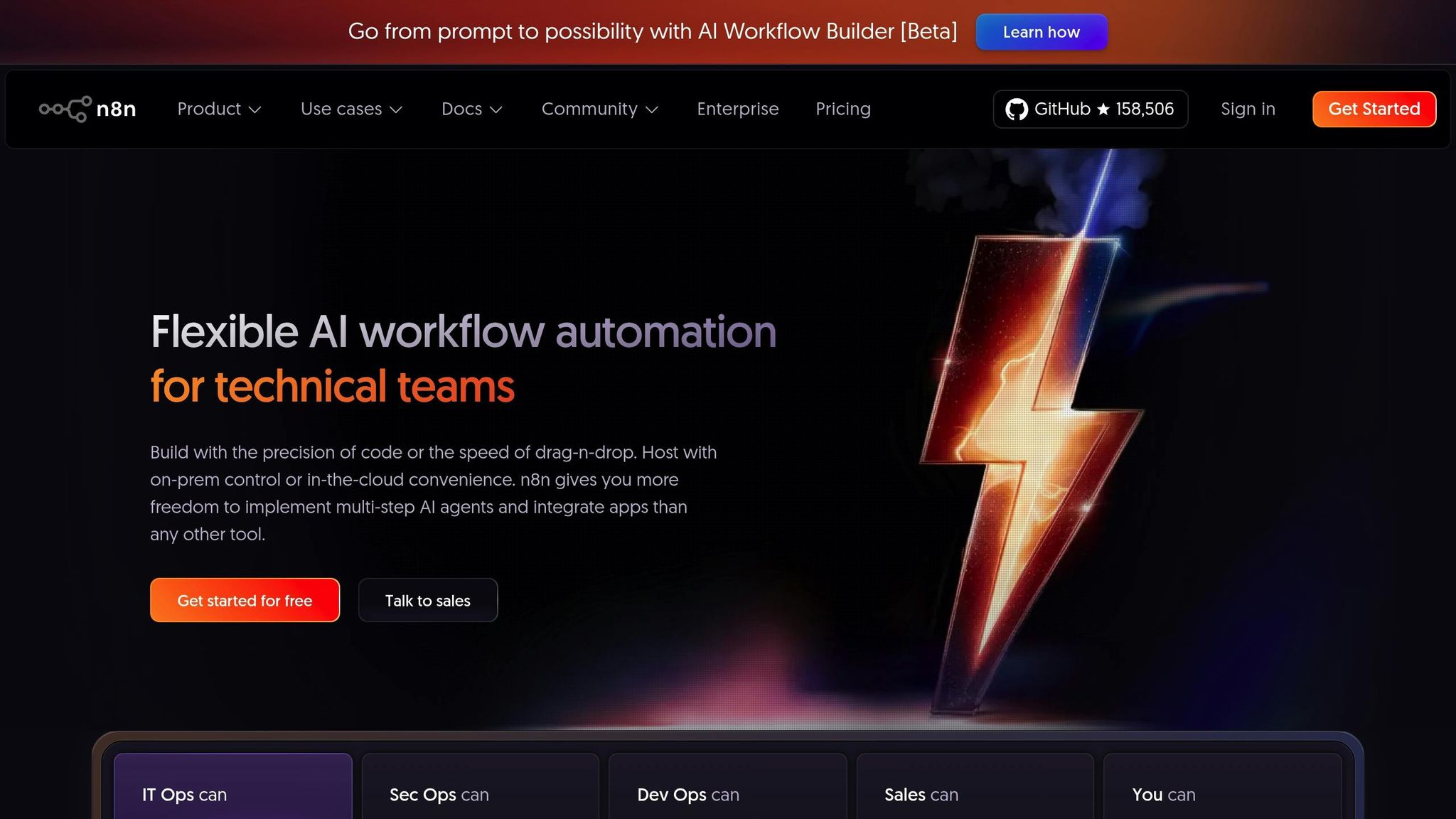
n8n is an open-source platform designed to automate workflows, offering a free self-hosted option for organizations that prioritize budget-friendly solutions while maintaining control over custom AI workflows.
It combines an easy-to-use no-code interface for non-technical users with advanced coding options for developers who need more customization.
n8n's open-source framework makes it highly adaptable, allowing integration with a wide array of AI tools and large language models. This adaptability ensures that organizations can incorporate the latest AI advancements into their workflows without being confined to pre-built connectors.
n8n offers detailed control for integrating AI processes with current systems. Its visual builder simplifies the process, but for more complex needs, developers can directly modify workflows at the code level. The open-source nature of the platform eliminates vendor lock-in, giving organizations the freedom to adjust the platform as necessary and retain complete ownership of their automation infrastructure.
n8n stands out for its affordability and pricing clarity. The free open-source version includes full functionality for teams managing their own hosting. For those who prefer managed hosting, plans start at around $20 per month, with annual billing options available at $23.50 per month.
The open-source design of n8n allows for scalability, making it suitable for deployment across multiple servers. This enables organizations to allocate resources effectively and fine-tune performance to meet specific workflow requirements. While this level of flexibility requires technical expertise, it empowers skilled teams to handle even the most complex automation needs. By offering both control and adaptability, n8n positions itself as a strong choice for managing advanced AI workflows.

Pipedream stands out as a developer-focused platform, offering a code-first approach for those who need serverless control and robust monitoring capabilities in their AI workflows. With a solid reputation, including a 4.6/5 rating on G2 and a perfect 5/5 on Capterra, it’s trusted by companies like Scale, Appcues, Logitech, LinkedIn, and Gorgias for automating workflows. Let’s take a closer look at Pipedream’s key features and how it supports advanced AI integrations.
Pipedream shines when it comes to connecting with AI tools and large language models. It offers a single SDK with thousands of integrations, enabling access to over 2,800 APIs and 10,000 tools through its MCP server. The platform also includes an AI agent builder, which allows teams to design AI-powered workflows using natural language inputs, reducing the need for extensive manual coding.
Pipedream simplifies event-driven integrations through real-time event sources and webhooks, making it easy to connect with existing workflows. Its logging and secret management features ensure that workflows run securely and transparently. While its app library is smaller compared to platforms like Zapier and Make, Pipedream compensates with flexible coding options, empowering developers to create custom integrations when pre-built connectors fall short.
The platform’s pricing structure is designed to scale with user needs. The free plan includes 100 monthly credits, 3 active workflows, and 2 million AI tokens. For $45/month, the Basic plan offers 2,000 credits, 10 active workflows, and 20 million tokens. Advanced users can choose the $74/month Advanced plan, which provides unlimited workflows and 50 million tokens. For production environments, the Connect plan at $150/month includes 10,000 credits, while Enterprise users can access custom pricing and dedicated support.
Thanks to its serverless architecture, Pipedream naturally scales to meet the demands of enterprise environments. Its observability tools make it easier for teams to manage and monitor complex workflows as they expand. While the platform is highly effective for technical teams, it’s less user-friendly for non-technical users, with some feedback pointing to a clunky interface and challenges in debugging. Additionally, its limited free plan and relatively higher costs may pose obstacles for teams with tighter budgets.
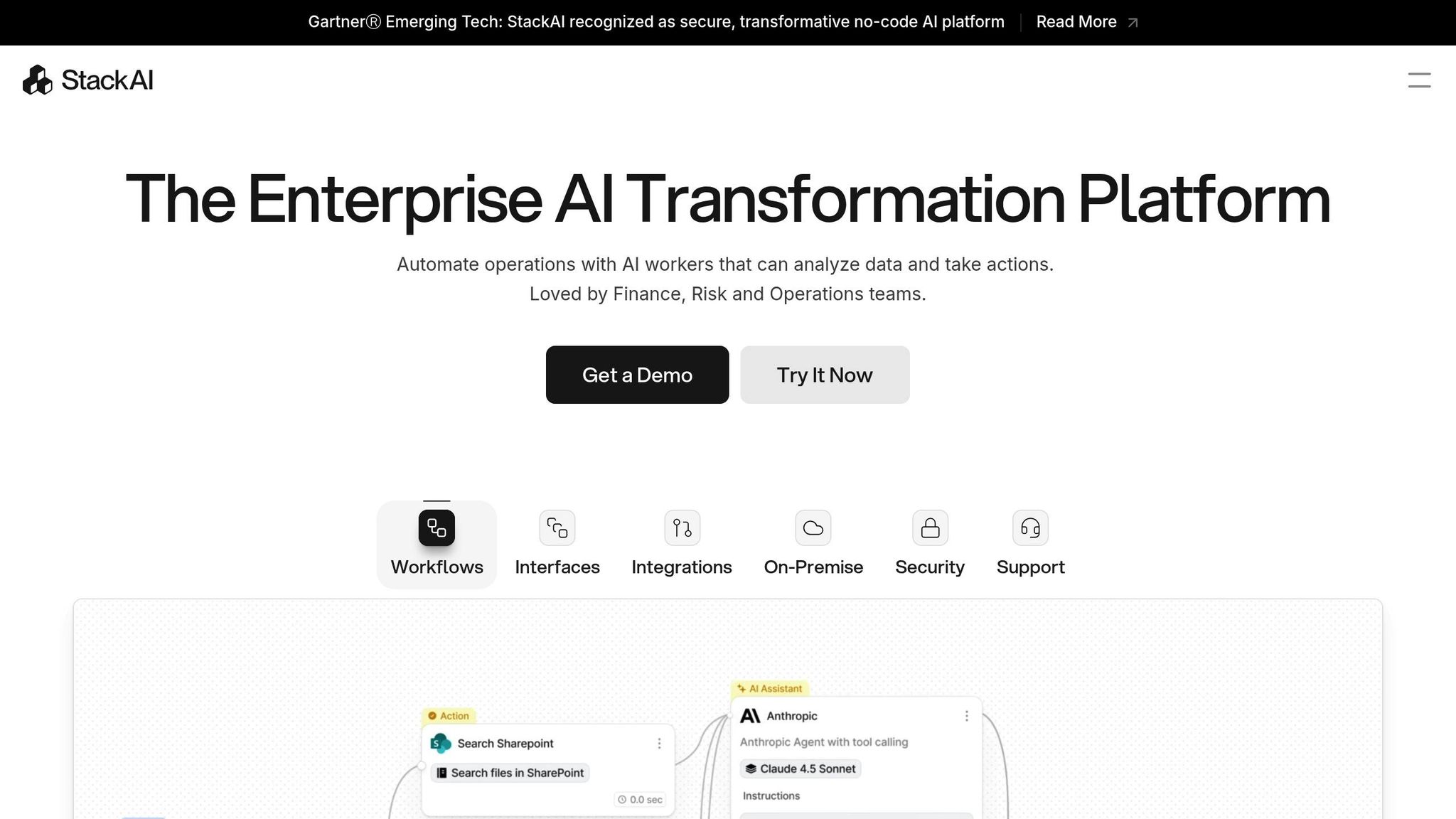
StackAI is crafted as an AI-native orchestration platform tailored for enterprises that prioritize strict compliance and regulatory standards. With a focus on advanced routing and knowledge ingestion, it proves especially beneficial for organizations operating in highly regulated sectors. Let’s dive into its key features, including interoperability, integration options, pricing, and scalability.
StackAI’s orchestration capabilities allow seamless integration of diverse data sources into intricate AI workflows, all while maintaining stringent data control measures.
One of StackAI’s standout qualities is its multi-deployment flexibility. Whether your organization relies on cloud-based systems, on-premises infrastructure, or a hybrid setup, StackAI adapts effortlessly. This flexibility ensures smooth integration with existing workflows, while its strong compliance and security protocols make it an ideal choice for environments with rigorous regulatory demands.
To help organizations explore its features, StackAI provides a free tier for evaluation purposes. For full-scale production, however, an enterprise contract is required. This pricing model highlights its focus on enterprise-grade functionalities and dedicated support services.
StackAI is engineered to handle large-scale operations, offering robust governance over complex AI processes. While its capabilities are well-suited for enterprise environments, it may be more than what small or mid-sized businesses with simpler automation needs require.

SnapLogic is a powerful enterprise integration platform that bridges applications, APIs, and data pipelines, all while incorporating AI-driven capabilities. Tailored for large-scale enterprises dealing with intricate data ecosystems, it introduces the SnapLogic Agentic solution. This feature allows the creation of intelligent agents that can efficiently manage workflows across multiple teams and systems.
SnapLogic's vendor-agnostic framework ensures organizations can seamlessly adopt, switch, or upgrade AI models without being locked into a single provider. Its Prompt Composer tool further enhances usability by enabling real-time testing and adjustments to AI agent behavior. This functionality empowers teams to fine-tune how agents interact with various models, ensuring smoother workflows and better alignment with enterprise needs.
With an extensive library of connectors and an AI-assisted builder, SnapLogic simplifies even the most complex integrations. It also prioritizes security, offering end-to-end encryption, data masking, and robust governance controls to safeguard workflows.
"SnapLogic is an enterprise integration platform spanning apps, APIs, and data pipelines with AI-assisted builder features." - vellum.ai
SnapLogic follows an enterprise-only pricing structure, with costs available through direct consultation with their sales team. While this approach allows for tailored solutions to meet the demands of large-scale operations, it may not be the most budget-friendly option for smaller organizations.
Built for large enterprises, SnapLogic provides governance and tracking tools designed for massive-scale operations. These tools monitor data flows, evaluate performance, and ensure compliance across complex AI workflows.
"Best For Large enterprises running app and data integrations at scale." - vellum.ai

Relevance AI takes a unique approach by focusing on agents specifically designed to handle intricate, multi-step tasks. The platform specializes in creating custom agents tailored to streamline complex workflows.
Relevance AI’s agent-centric design ensures smooth compatibility with various tools and large language models. Users can create agents by simply naming them and providing straightforward instructions. For instance, you could define an agent as "a helpful assistant that scrapes LinkedIn, writes outreach emails, and transforms replies into blog posts". These agents can connect with external tools like Google Search or Slack and collaborate with other sub-agents to manage more elaborate processes.
The platform makes it easy to integrate AI into existing workflows. With its "describe your agent" feature, users only need to explain the task they want completed. The platform then automatically configures the agent, removing technical hurdles and making AI accessible to everyone.
Relevance AI keeps pricing straightforward, starting at $19 per month. This clarity ensures that users can confidently plan their budgets while benefiting from agent-based automation.
The platform’s modular, multi-agent architecture is designed to grow with your needs. Specialized agents can collaborate on complex tasks, ensuring the system scales effortlessly as workflows expand and evolve.
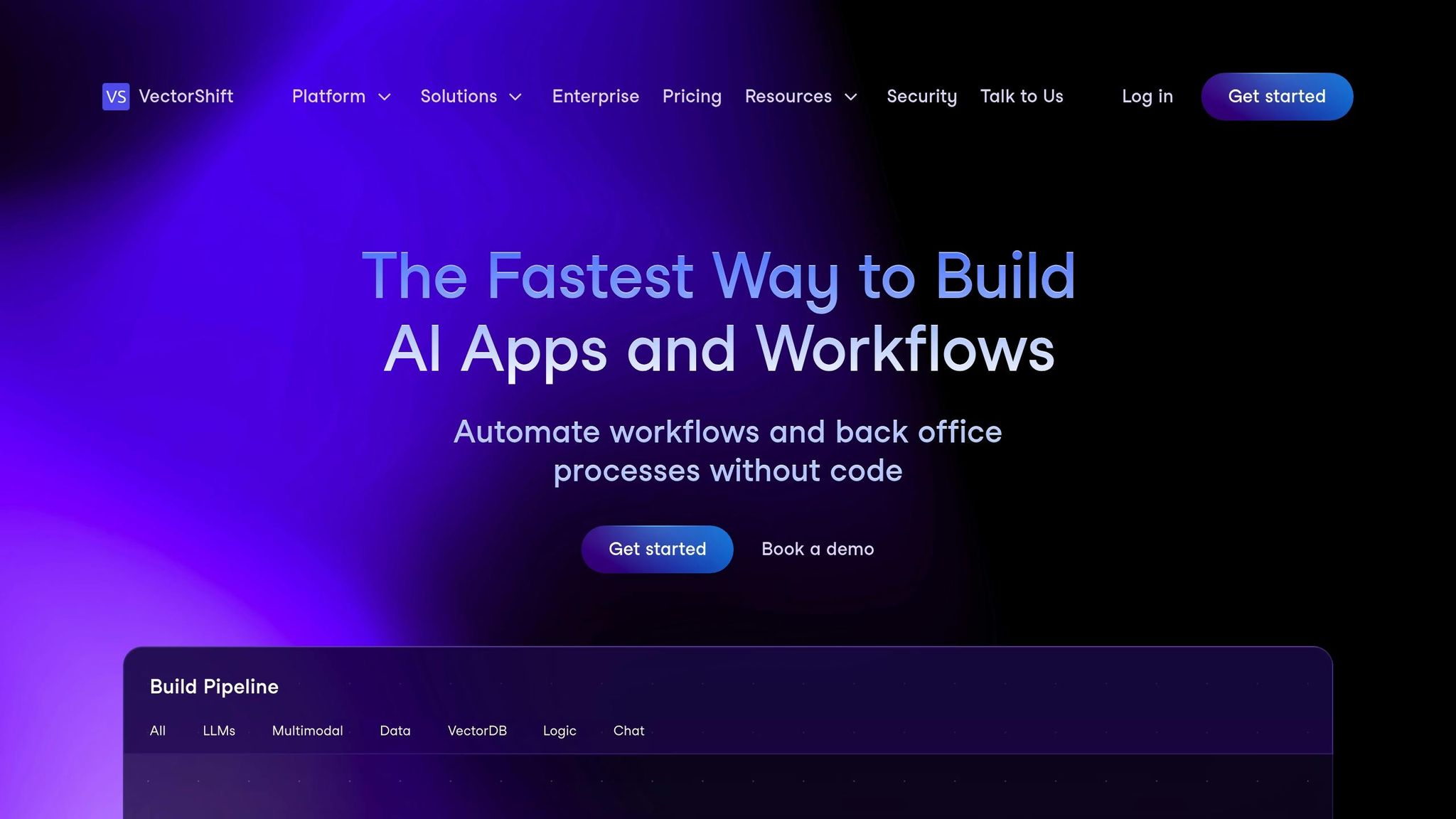
VectorShift is a platform tailored for developers, offering a bridge between no-code solutions and advanced developer-level tools. Launched in 2023 with $3.5 million in funding, it caters to technical teams seeking robust AI workflow capabilities. Its design ensures seamless integration with a variety of AI tools.
VectorShift’s multi-LLM architecture connects with leading providers like OpenAI, Anthropic, Hugging Face, and Mistral AI. This setup allows teams to harness the strengths of different models within a unified workflow. Users can choose between a drag-and-drop builder and a Python SDK, depending on their preferred development style. The platform supports creating intricate pipelines, such as analyzing data from Notion databases, processing it through models like GPT-4, and automatically sharing results on platforms like Slack.
To make onboarding simpler, VectorShift includes pre-built templates and examples, helping users get started quickly. Another standout feature is its "Voicebots" capability, which lets users create voice-activated bots for hands-free workflow management.
Integration is straightforward with VectorShift’s dual-interface approach: a Python SDK for developers and a visual builder for non-technical users. This flexibility allows organizations to add advanced AI functionalities to their workflows without needing to overhaul existing systems. Its pipeline architecture supports complex, multi-step workflows, efficiently connecting data sources with output channels.
Plans start at $25 per month, offering access to its advanced capabilities and multi-LLM support. While the pricing reflects the platform's sophistication, it’s particularly suited for technical teams and businesses with specific, complex AI workflow needs. For organizations relying on multiple language models or advanced automation, the investment can deliver substantial value.
Built with developers in mind, VectorShift adapts as technical teams grow. Its combination of visual tools and a Python SDK enables rapid prototyping, which can evolve into enterprise-level solutions. The platform’s multi-LLM support ensures flexibility for long-term AI strategies, making it a reliable choice for scaling operations.

Gumloop is a no-code platform built specifically for advanced workflow automation, with artificial intelligence at its foundation. Unlike traditional tools that later added AI functionality, Gumloop was created from the ground up with AI in mind. Its design revolves around modular components, called "nodes", which allow users to build AI-driven automations without needing coding expertise. This node-based approach aligns perfectly with the article's focus on advanced AI workflow management, placing Gumloop in the spotlight alongside other platforms.
Gumloop's architecture is designed to integrate effortlessly with various AI tools and large language models. Its node-based system supports a range of specialized templates for tasks like finding internal linking opportunities, analyzing legal contracts, and evaluating lead websites. One standout feature is its Chrome extension, which records browser actions and converts them into repeatable automations. This is particularly useful for web scraping or automating interactions on sites without APIs. Additionally, the platform includes "subflows" for creating nested actions and an "Interfaces" feature, which allows external users to trigger automations by providing input data. These capabilities make it easy to incorporate Gumloop into existing workflows, enhancing efficiency and flexibility.
While Gumloop is a no-code platform, it does have a slightly steeper learning curve compared to simpler automation tools, making it more suitable for users with a technical background. However, this complexity is balanced by its powerful features, such as a library of 90 pre-built workflows and templates. Its user-friendly interface and reusable subflow components make it easier to design, implement, and scale intricate workflows systematically.
Gumloop offers paid plans starting at $97 per month, reflecting the platform's advanced AI capabilities. This pricing is tailored for businesses with complex automation requirements, allowing them to fully utilize its specialized features, including browser-based automations. The cost structure ensures businesses can scale their workflows effectively without sacrificing functionality.
Thanks to its modular architecture, Gumloop is well-equipped to manage a wide range of automation needs as businesses grow. The inclusion of subflows enables the creation of interconnected, advanced workflows that can adapt to evolving organizational demands.
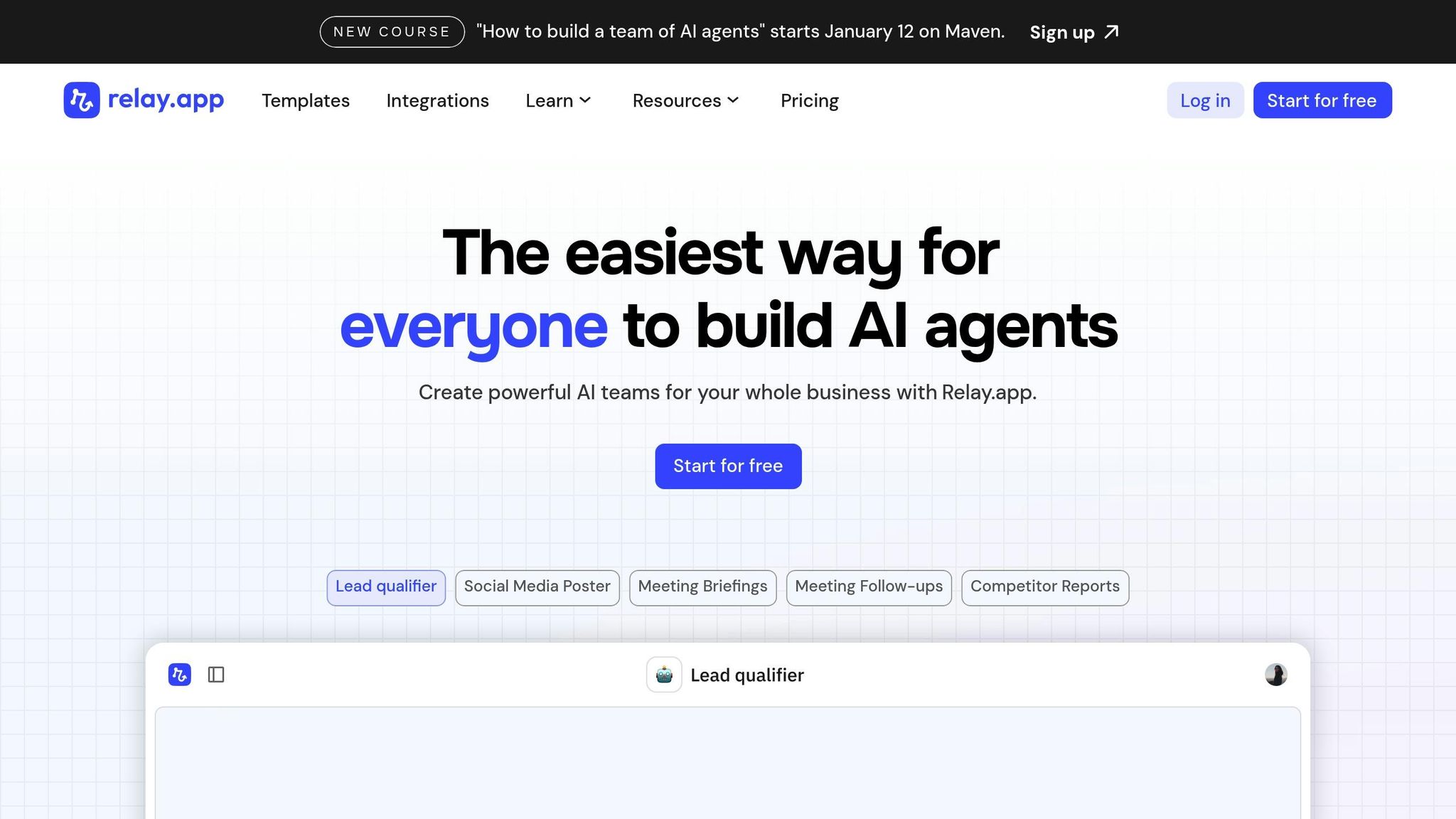
Relay.app transforms workflow automation by placing AI at the heart of its design. Unlike traditional tools that treat AI as an optional feature, Relay.app uses artificial intelligence as the foundation for building and deploying agents. These AI agents are crafted using simple natural language descriptions, making it easier than ever to integrate AI into a wide array of tools and processes.
Relay.app stands out for its ability to connect seamlessly with major large language model (LLM) providers, including Anthropic, Google Gemini, Groq, Mistral, OpenAI, Qwen, and xAI. This extensive LLM integration allows users to tap into cutting-edge AI capabilities without the hassle of switching between platforms.
Beyond LLMs, Relay.app integrates with tools like Fireflies.ai for meeting transcription analysis, ElevenLabs for AI voice generation, HeyGen for video creation, and Perplexity for AI-driven search. These integrations enable AI agents to handle an impressive range of tasks, such as research, data analysis, content summarization, decision-making, and creating multi-format content.
Relay.app’s AI agents are designed to gather data, create content, and coordinate actions across multiple tools. This orchestration makes it an invaluable resource for businesses needing advanced, AI-powered workflows.
With Relay.app, creating AI agents is straightforward. Users can describe workflows in plain language, and the platform’s intuitive drag-and-drop interface makes it easy to design even complex automations. The inclusion of a "human in the loop" feature allows for manual reviews, approvals, and team collaboration, ensuring flexibility in AI-driven processes.
Users have praised the platform’s simplicity and usability:
"Just ran my first automation workflow with @relay! I wanted to send newsletters from Outlook to Notion, and it was so easy I almost cried - after struggling and giving up with other tools like Make. Huge thanks to @relay for empowering non-tech folks like me!"
Lucas Grey shared his experience automating tasks with Relay.app:
"Falling in love with @relay. Tried make and zapier and this uiux worked the simplest. It gets the job done. Automated our waitlist collection and replying process. Used gpt in the workflow to parse the replies to our waitlist email qtns & saved them into our notion database."
Relay.app delivers not just flexibility but also enterprise-level reliability. Built with security and compliance in mind, it is SOC 2 compliant, ensuring robust data protection. Its collaboration features allow teams to build, run, and share AI agents, making it a practical choice for organizations of all sizes.
The "human in the loop" approach also provides critical oversight for enterprise workflows. As Benjamin Borowski highlighted:
"Relay's "human in the loop" model is super effective for teams. Not only is this the best designed UI for automation building on the market, they've really thought about how not everything can be automated. Fantastic for building operationalized SOPs."
Relay.app combines cutting-edge AI integration with user-friendly design and enterprise-ready features, making it a standout solution for modern workflow automation.
AI workflow management tools have become essential for streamlining automation across organizations. A great example is Prompts.ai, which orchestrates over 35 large language models while incorporating FinOps features to manage costs effectively.
These platforms are designed to meet the varied needs of enterprises and small to medium businesses (SMBs). Larger organizations often require solutions that prioritize governance and cost efficiency, while SMBs may find tools like Zapier and Make ideal for simpler, more accessible automation. For technical teams, open-source platforms like n8n offer the adaptability needed for custom workflows.
A key factor in successful AI workflow management is seamless integration with leading LLM providers. Platforms that connect effortlessly with existing tools and systems - such as OpenAI, Anthropic, or Google Gemini - help reduce tool sprawl and enhance functionality. Scalability is another critical consideration, with enterprise-grade platforms often excelling at meeting complex compliance and oversight requirements. Features like human-in-the-loop processes ensure that mission-critical workflows maintain the necessary checks and balances.
Transparent pricing models, such as pay-as-you-go options, address inefficiencies tied to fixed subscriptions, making them more suitable for variable workloads.
To choose the right platform, focus on aligning its features with your specific workflow challenges. Consider factors like your team's technical skills, integration needs, compliance demands, and future growth plans. Evaluating these elements will help you identify the platform best equipped to meet your goals.
Whether you're automating routine tasks or managing intricate AI-driven operations across departments, these tools provide the foundation for efficient and scalable workflows. The right platform can significantly enhance productivity and simplify operations, tailored to your organization's unique objectives.
When selecting an AI workflow management system, it's essential to weigh several critical factors. Begin by examining the total cost of ownership - this includes not only subscription fees but also implementation expenses and potential costs for training and ongoing support. Understanding the full financial picture helps avoid surprises down the line.
Next, review the system's integration capabilities to ensure it works seamlessly with your current tools and infrastructure. Equally important is its AI readiness - check if it supports advanced functionalities like large language models and automation features that align with your goals.
Pay close attention to data security and compliance to confirm the platform adheres to your organization's privacy and regulatory standards. Additionally, consider the vendor's stability and long-term roadmap to ensure they can support your needs as your organization evolves.
Lastly, evaluate the platform's usability. A system that fits naturally into your team's workflows will enhance productivity and efficiency, making day-to-day operations smoother and more effective.
Prompts.ai provides a powerful solution for managing AI workflows in enterprise environments. It streamlines intricate processes, scales operations with ease, and leverages advanced AI to automate repetitive tasks. Additionally, it allows businesses to compare top-performing large language models (LLMs) effortlessly, all within a unified platform.
By reducing manual work and fine-tuning workflows, Prompts.ai helps companies save valuable time and lower expenses while boosting productivity. Its user-friendly interface and comprehensive features make it a go-to choice for organizations aiming to simplify and enhance their AI-powered operations.
AI workflow management systems ensure data protection and regulatory compliance, adhering to standards like GDPR and HIPAA, through rigorous security protocols. These include advanced encryption, strict access controls, and anonymization methods to safeguard sensitive information.
Additionally, these systems incorporate automated tools to monitor compliance, perform risk assessments, and generate regulatory reports. Regular security audits and incident response drills further strengthen data security and alignment with legal standards. By embedding privacy and governance principles into their framework, these systems enable organizations to maintain compliance while streamlining their workflows.


